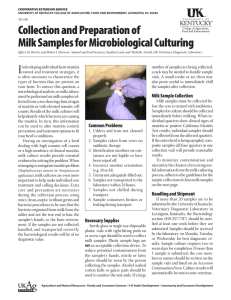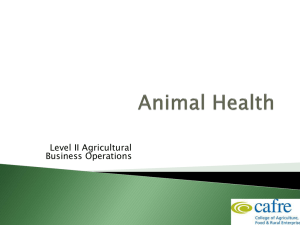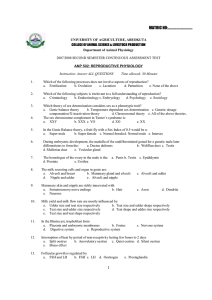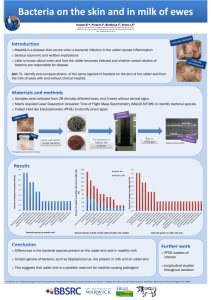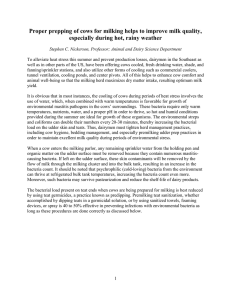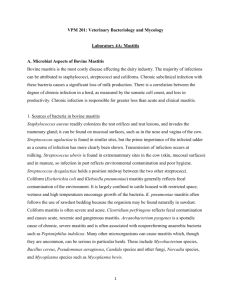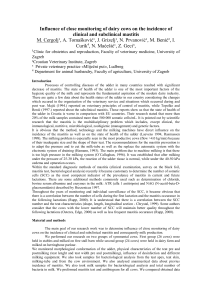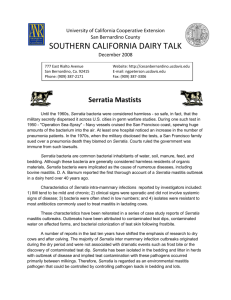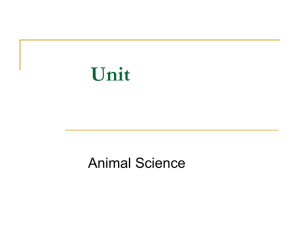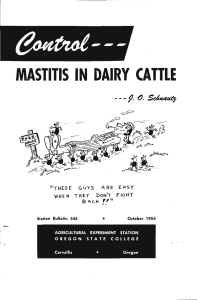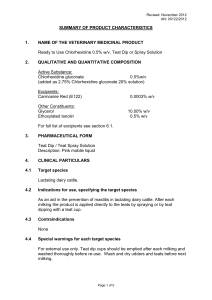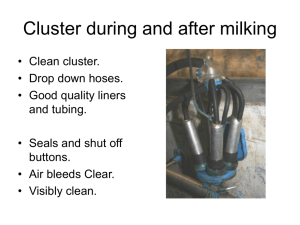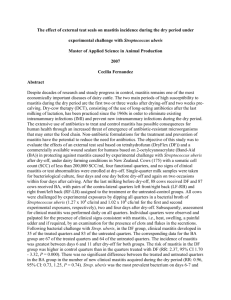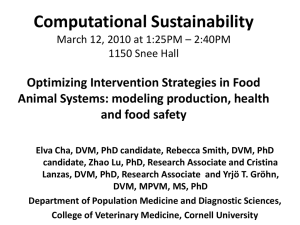Mastitis Prevention and Treatment
advertisement
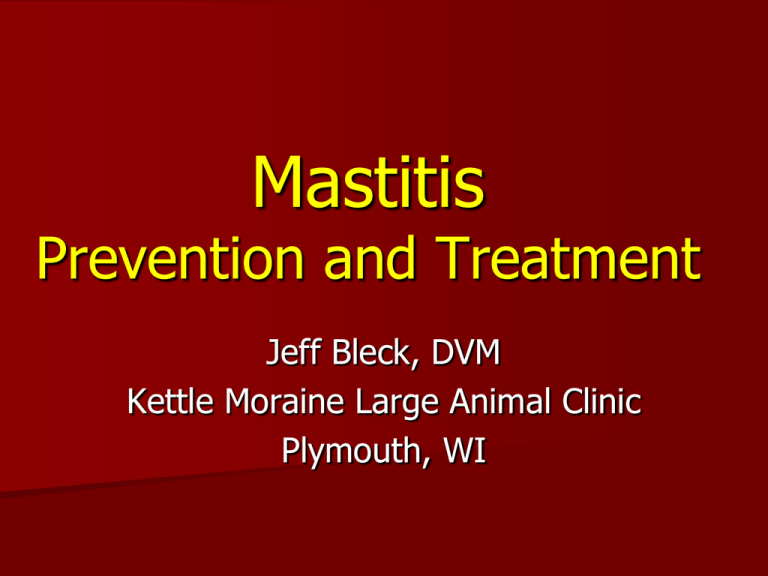
Mastitis Prevention and Treatment Jeff Bleck, DVM Kettle Moraine Large Animal Clinic Plymouth, WI Mastitis Happens! Focus on: A. Prevention 1. Vaccinations 2. Environment 3. Milking process B. Treatment 1. Culturing Programs 2. Appropriate Therapy Mastitis is often the end result of the interaction of several factors. MASTITIS MICROORGANISMS Mastitis Vaccines Effective Immunization is Difficult – Volume of milk dilutes the # of immune cells – Fat and casein reduce bactericidal abilities of immune cells – Cows are exposed to numerous bacteria – Milk is an excellent substrate for growth Vaccine Types Staphylococcus aureus – Somato-Staph – Lysigen E. Coli – J-5 Bacterin – J-Vac – Endo-Vac Bovi Use gram-negative core antigens to produce non-specific immunity directed against endotoxic disease Compliance? 60-80% 30-40% 80 % Protection 70 60 50 40 30 20 10 0 1 2 J5 Shot # 3 E. Coli Vaccination Programs Farm Specific-Based on Bacterial challenge – Three shot program – Quarterly – Seasonally – Monthly – Hyper-immunization SRP Vaccine Technology All that stands between the udder and infection… Anatomy of Teat Defense Cow Environment CLEAN “ Hygiene is a dominant factor in mastitis control, influenced primarily by cow comfort, ventilation and bedding” Fetrow et al (2002) Minimize bacterial load /maximize immunity Dry Clean Comfortable Correlation Between Bedding Contamination and the Bacteria in Milk Bedding cfu/gm Milk cfu/ml Pen # 1 817,000,000 960 Pen # 2 498,000,000 405 Pen # 3 270,000,000 215 Farnsworth & Reneau Unpub, 1989 "Creating Your Playbook for Success" - A course for Parlor Managers. Bacteria Counts on Individual Sand Samples (cfu/cc) --------------------------------------------------------------------------------------------------------------------------------------------- Dairy Surface Subsurface Bottom A 2,897,500 10,235,000 5,647,000 B 1,750,000 21,600,000 46,349,000 C 45,325 D 5,625,500 18,900,000 38,505,000 80,475 23,925 Bedding Frequency Critical to decreasing bacteria numbers in stalls Bedding sand on schedule of 3 times in 2 weeks. Grooming with cement hoe at each shift. Goal Keep total bacteria counts below 2-4 million Keep coliform bacteria counts below 1 million (1,000,000 /cc). Keep environmental streptococci below 1-2 million/cc. Environmental hygiene is critical in preventing environmental mastitis. Keep Bedding materials as dry as possible. What Are The Stalls Telling You?? More manure, more mastitis! Conclusion • Controlling exposure to environmental pathogens between milkings is important for udder hygiene. • Bedding material must be properly maintained to reduce exposure, prevent udder infections and reduce SCC. • Bedding materials must be carefully selected. Now its time to move into the parlor or milking barn. >75% of Clinical Mastitis occurs during the milking process Clean!Clean!Clean! Milkers must wear gloves! And Keep them Clean! Keep Milking Units Clean Keep cow platforms Clean GLOVES I tried them and didn’t see any improvement! What We Know Positive relationship exists between bacteria on teat ends and intramammary infections (Newbold, 1970, NMC). Rates of clinical mastitis are related to bacterial counts in bedding (Hogan, et. al, J. Dairy Sci 72:250, 1989). Exposing teat ends to >1,000,000 coliform bacteria increases the probability of intramammary infection (Bramley and Neave Br. Vet. J. 131:160, 1975). Udder Prep Research clearly shows the BEST you can do is reduce bacteria numbers by 85% with a perfect milking routine. 1,000,000 Bacteria At Start 150,000 After Cleaning 100,000 Bacteria At Start 15,000 After Cleaning Milking procedures / machines Flies Weather Other stressors Maximize Teat End Health >80% should score 1 or 2 Focus on Cleaning teat ends! Bacteria Normal Routine No Teat Ends ENVIRONMENTALS Strep Species 2,450 Coliforms 22,500 Normal Routine Clean Teat Ends 25 5 Best Ways to Reduce Bacteria on Teats Compared to No Udder Prep Dry Towel Only -4% Wet Towel Only -40% Wet Towel + Udder Sanitizer -40% Wet Towel and Manual Dry -77% Wet Towel, Udder Sanitizer, and Manual Dry -80% Predip and Manual Dry -85% Source: Cornell University Adequate Drying – Moisture is a growth requirement for bacteria Herds that dried teats had SCC 44,000 cell/ml lower than herds that did not – Moxley et al., 1978 Effect of Drying on Most important step in premilking hygiene Wet towels can’t adequately dry teats Bacterical Counts of Milk CFU per ML 5000 4500 4000 3500 3000 2500 2000 1500 1000 500 0 Bacterial Staph spp. Count Count Wet Towel, Sanitizer, NO DRYING Wet Towel, Sanitizer, DRYING Galton et al., 1984 Teat End Cleanliness Goal >85% 1’s and 2’s Remember, what is on the teat end when the milking unit is attached goes in the tank. Look at bulk tank records! – High environmental counts (coliforms or non-ag streptococcus, and staphylococcus species) are good indicators better cow hygiene (pre-milking cow preparation) and better bedding management is needed. Unit Cleanliness Keep units off of the platform Drop hoses should contain sanitizer with proper concentration Wash units between groups or as needed – Keep liner heads clean and vent holes open – Drying liner heads when wet or dirty Keep platforms clean Unit Alignment Much more important than people think! Unit must be square on udder with forward pull to get even milk outs and minimize slips Don’t forget about teat alignment – Make sure teat is properly seeded in the liner and not twisted Kink short milk tube to limit air admission Poor Tie Stall Alignment Teat Dipping Primary Reason to Teat Dip is to Remove the Milk Film Left on the Teat After Milking With a Layer of Germicide Teat Dip Coverage Pre and Post Dip or Foam coverage should be at least 75% Culturing Programs Need appropriate sample collection and storage Must have a plan to utilize information – Individual cow cultures-fresh, clinicals, high scc cows (two different plans) – Bulk tank cultures – Bedding cultures If you don’t have a “game plan” don’t waste your money! Bulk Tank Cultures - - Utilize your bulk tank cultures because they are a source of information on how good your cow’s teats are being cleaned. Bulk tank cultures definitely show inconsistency! Management Tip: - Monitor milker performance trends using BTC by shift. Clinical Mastitis Grading System Grade 1 – mild (milk only - clots & flakes) Grade 2 – moderate (milk & udder swelling) Grade 3 – severe (milk, udder swelling & cowsystemically sick) Antibacterial Therapy Response to Treatment Influenced by: – Cows immune response – Severity of mastitis – Duration of infection – Causative pathogen – Drug used The targeted compartment should be considered when choosing antibiotic treatment Milk- environmental Streps. And Staphs. Blood- E.coli, Klebsiella Mammary tissue- Staph. Aureus, some Streps, E.coi All IMM Drugs are Time Dependent Must give at periodic regular intervals (8, 12, 24 hours) Extending the duration of therapy better than a higher dose Failure of Therapy 1. 2. 3. 4. 5. Stopping therapy to soon Swollen udder parenchyma/blocked milk ducts Scar tissue/micro-abcesses Inactivation by milk and tissue proteins Microbial resistance Treatment Protocols Grade 1 1) IMM tube for 3 days Grade 2 1) IMM tube for 5 day 2) Anti-inflammatory drug Grade 3 1) IMM tube for 7 days 2) Anti-inflammatory drug 3) Supportive fluid therapy 4) Systemic Antibiotic Blanket protocols don’t always work! Example: Cow#100-mastitis LR, Grade 1 DIM=180, PG-90days, Milk=65lbs. xmast=4, SCC=3 million, cultureenvironmental strep. What treatment option would you choose? Treatment Decisions 1. Treat as per protocol 2. Culture and use extended therapy treatment 3. Move to hospital until no sign of clinical mastitis.(No Treat) 4. Dry up quarter 5. Quarter milk 6. Dry off cow early(double dry treat, etc) 7. Cull cow 8. Remove teat Clean Cows=Less Mastitis=More Milk
